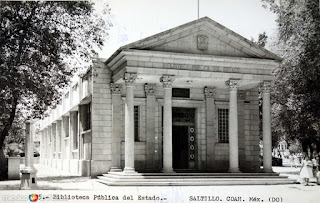In this post, I write about finding a photograph of me standing in front of a public library in Saltillo, Mexico.
 |
| Greig poses in front of a public library in the city of Saltillo in Coahuila, Mexico (c. 1998). |
On a Trip to Mexico When I was Seventeen and a College Seminarian
I am guessing my friend Tony took this photograph of me standing in front of a public library in Saltillo, Mexico, sometime in 1998 or 1999. I am about seventeen years old in this picture — and I was on a trip to Mexico with a bunch of seminarians.
Finding Old Pictures of Me (And Why I Love Libraries)
I found the photograph in a stack of pictures that I had stashed away at my mother's house in Louisiana. Armed with my photo scanner (i.e., my iPhone), I scanned the picture. At first, I had no recollection of where the picture was taken. We had gone to a few cities on this trip, having driven a van from New Orleans, Louisiana, to Laredo, Texas, to Monterrey, to Saltillo, and then to Mexico City. Was the picture taken in Mexico City? No. In Monterrey? No. After a bunch of failed internet searches, I finally found out the picture's location after stumbling upon a similar-looking building on a website dedicated to the history of Mexico via photography. Voila! It's the public library in Saltillo (located in the Mexican state of Coahuila!), La Biblioteca Publica del Estado.
I look thrilled and content in the photograph. I am obviously excited to be standing in front of the library. Here is the library from an archival photograph I found:
 |
| La Biblioteca Publica del Estado, Coahuila, Saltillo — Image Credit: Photo archived by Gerardo Zárate |
The Symbolism of the Library (for me)
Libraries are symbolic for me — they symbolize free access to information, reading, literacy, and learning that attempt to scale above the prescription that education is fixed and only for a certain type of people. I love how the door to this library is open — adorned with Corinthian columns, another symbol — of the liberal arts — and people are seated on the steps. Libraries are public spaces, as well as places of learning and knowledge.
When you visit a new place, where do you like to go? Let me know in the comments.






